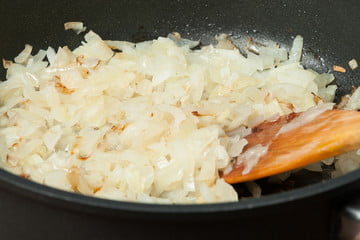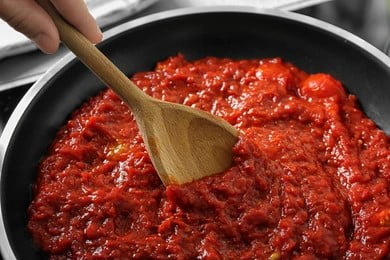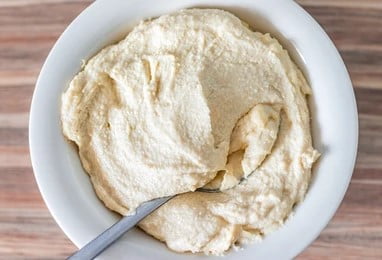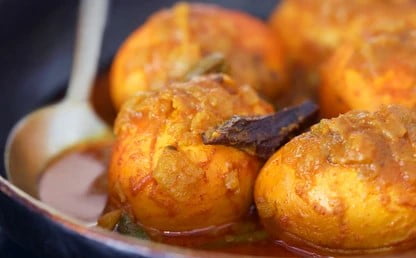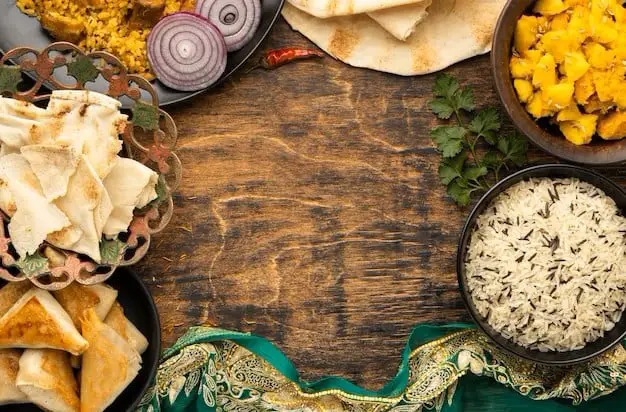Shahi Egg Curry is a special dish from India that’s loved for its amazing taste and history. It’s a recipe that comes from the royal kitchens of India, where it was made for kings and queens.
This dish isn’t just about food; it’s about tradition and bringing people together. The spices, creamy sauce, and wonderful smell make it a dish that reminds people of good times spent with family and friends.
Making Shahi Egg Curry isn’t just about cooking; it’s an art. Every step, from choosing the right spices to cooking everything perfectly, is really important to make it taste amazing.
People all over the world love this dish because it’s so delicious and can be enjoyed on special occasions or just when you want something comforting.
In this article, we’ll explore everything about Shahi Egg Curry—its history, how it’s made, how it can be served, and even why it’s good for you. Let’s take a tasty journey into the world of Shahi Egg Curry!
Table of Contents
History of Shahi Egg Curry
Shahi egg curry has a long history in Indian culinary tradition as it has evolved over centuries through various spice blends, cooking techniques and cultural influences.
Historical Sources:
Shahi egg curry, translating to “royal egg curry”, has its roots in Mughlai cuisine, a notable culinary tradition in northern India, particularly associated with the Mughal Empire. Rich and spicy recipes like Shahi egg curry are influenced by the Mughals, who were famous for their lavish lifestyle and sophisticated taste.
Mughal Influence:
During the Mughal era, which spanned from the 16th to the 19th century, their royal kitchens were famous for their royal feasts and elaborate dishes using a mix of Indian spices and Persian cuisine.
Royal ingredients such as nuts, dry fruits and aromatic spices made this dish a symbol of wealth and royalty.
Traditional Cooking Method:
Cooking methods for Shahi egg curry changed over time, with Mughal chefs using complex techniques to create a velvety, flavorful gravy. They were adept at mixing spices like cardamom, cinnamon, cloves and saffron to create a unique flavor profile for a king or queen.
Regional Adaptation:
Although Mughal influence predominates, regional variations of Shahi egg curry have emerged across the Indian subcontinent. Different regions add their own uniqueness to this recipe by incorporating their local ingredients and flavors. For example, in some areas, the addition of coconut milk or nuts can set the dish apart.
Cultural Significance:
Over time, Shahi egg curry has not only become a symbol of culinary excellence but also a dish served on special occasions including weddings, festivals and celebrations. Its rich history and royalty have added to its popularity, making it a respected part of the world of Indian cuisine.
Continuous evolution:
Shahi egg curry continues to adapt as cuisine evolves and diversifies. Modern variations can incorporate contemporary ingredients or cooking techniques and still retain the essence of its historical roots.
Shahi egg curry originated in the Mughal court kitchens and the dish retains its royal appeal even today. People across the country and even the world love this Indian dish, which is becoming more and more popular as a delicious and accessible recipe.
Ingredients Required for Shahi Egg Curry
For the Base Gravy:
- Onions: 2 large, finely chopped
- Tomatoes: 4 medium-sized, pureed
- Ginger-Garlic Paste: 2 tablespoons
- Cashew Nuts: 3/4 cup, soaked in water for 30 minutes
- Yogurt: 1/2 cup, whisked
- Oil or Ghee: 3-4 tablespoons
- Bay Leaf: 2
- Cinnamon Stick: 1-inch piece
- Green Cardamom: 3-4 pods
- Black Cardamom: 2
- Cloves: 3-4
- Turmeric Powder: 1/2 teaspoon
- Kashmiri Red Chili Powder: 1 teaspoon
- Coriander Powder: 1 tablespoon
- Garam Masala: 1 teaspoon
- Salt: To taste
- Butter: 2 tbsp
For the Eggs and Final Preparation:
- Hard-boiled Eggs: 6, peeled and halved lengthwise
- Milk or Cream: 1/4 cup
- Saffron Strands: A pinch (optional, for an enhanced flavor and color)
- Kasuri Methi (Dried Fenugreek Leaves): 1 tablespoon, crushed
- Fresh Cream: 2 tablespoons
- Sugar: 1 teaspoon (optional, to balance flavors)
- Coriander Leaves: For garnishing
Optional Ingredients for Variation:
- Paneer (Indian Cottage Cheese): Cubed and lightly fried
- Almonds: Replace or combine with cashews for a different flavor
- Raisins: For a hint of sweetness in the curry
These ingredients form the core components necessary for crafting a flavorful and rich Shahi Egg Curry. Adjust the spice levels and additional ingredients according to personal taste preferences.
Cooking Steps:
Prepare the Base:
- Heat oil or ghee in a pan. Add cumin seeds, cardamom pods, cinnamon, and cloves. Give them time to sizzle for a few seconds.
- add the finely chopped onions and Saute it until they turn golden brown.
Cook for a further minute after adding the ginger-garlic paste, or until the raw smell is gone.
Create the Gravy:
- When the oil separates from the mixture, add the tomato puree to the pan and continue cooking.
- Add 2 tablespoon butter in it.
- Stir in the salt, turmeric, coriander, and Kashmiri red chili powders.
- Now when all the ingredients are well mixed turn off the gas.
- When the mixture cools down a little, blend it with the rest of the mixer.
- Now strain it with the help of a strainer.
- Pour this smooth mixture back into the pan.
Integrate Creaminess:
- In a blender, combine soaked cashew nuts with a little water and blend into a smooth paste.
- After lowering the heat, Pour the cashew paste. Stir and cook for 2-3 minutes, allowing the flavors to meld.
- Gradually add yogurt, stirring continuously to prevent curdling. Cook until the gravy thickens slightly.
Incorporate Eggs:
- Gently add the boiled eggs to the gravy.
- Let them simmer in the sauce for about 5-7 minutes, ensuring they absorb the flavors.
Final Touch:
- Sprinkle garam masala over the curry.
- Taste and adjust salt and spice amounts accordingly.
- Garnish with freshly chopped coriander leaves.
Serve:
- Shahi Egg Curry is best served hot with naan, rice, or roti.
Tips:
- Adjust the spice levels according to your preference. For a milder curry, reduce the amount of red chili powder.
- You can prick the boiled eggs with a fork before adding them to the gravy to allow the flavors to penetrate.
- If the gravy is too thick, adjust the consistency by adding a little water or cream.
- These detailed instructions will guide you through the process of creating a delicious Shahi Egg Curry, rich in flavors and aroma, perfect for a satisfying meal.
Serving Suggestions for Shahi Egg Curry
Shahi Egg Curry, with its rich flavors and creamy texture, pairs wonderfully with various accompaniments, enhancing its taste and making it a complete meal. Here’s how you can serve it:
1. Rice Varieties:
- Basmati Rice: The aromatic long-grain Basmati rice is an excellent choice to complement the flavors of Shahi Egg Curry.
- Jeera Rice: Infused with cumin seeds, this rice adds a subtle earthy flavor that pairs delightfully with the richness of the curry.
- Saffron-infused Rice: Adding saffron strands while cooking rice elevates the meal, offering a luxurious touch.
2. Bread Options:
- Naan: Soft and slightly chewy, naan bread is perfect for soaking up the creamy sauce of the curry.
- Roti/Chapati: These unleavened flatbreads balance the richness of the curry and provide a lighter option.
- Paratha: The flaky, layered texture of paratha complements the creamy curry, creating a delightful combination.
3. Accompaniments:
- Salad: A fresh salad with cucumbers, tomatoes, onions, and a tangy dressing adds a refreshing contrast to the richness of the dish.
- Raita: Yogurt-based raita, with a hint of spices and fresh herbs like mint or cilantro, offers a cooling element alongside the flavorful curry.
- Papad: Crispy and thin, papadum or papad adds a delightful crunch to the meal.
4. Garnishes and Extras:
- Fresh Herbs: Finely chopped cilantro or mint leaves sprinkled on top add a burst of freshness and color.
- Sliced Almonds or Cashews: Toasted nuts serve as a crunchy garnish, enhancing both the taste and texture of the dish.
- Lemon Wedges: Squeezing a wedge of lemon over the curry just before serving adds a zesty touch, balancing the richness.
5. Presentation Tips:
- Serve in Elegant Dishes: Utilize decorative bowls or plates to showcase the vibrant colors of the curry.
- Layering Technique: Placing a bed of rice or bread at the base of the plate and ladling the curry over it can create an appealing visual presentation.
6. Dietary Considerations:
- Gluten-Free Options: Opt for gluten-free bread varieties like gluten-free naan or rice-based bread for those with gluten sensitivities.
- Vegan/Vegetarian Choices: Offer alternatives such as tofu or paneer (Indian cheese) in place of eggs for vegetarian or vegan preferences.
Experimenting with these serving suggestions can elevate the dining experience, ensuring that the Shahi Egg Curry becomes a memorable and satisfying meal for all those indulging in its flavors.
Health Benefits
A. Nutritional Profile
- Shahi Egg Curry boasts a rich nutritional profile, providing essential vitamins, minerals, and macronutrients that contribute to overall well-being. The key components include:
- Protein: Eggs are a complete protein source, containing all the essential amino acids necessary for muscle repair, growth, and maintenance.
- Vitamins: Eggs are a good source of vitamins, particularly vitamin B12, which is crucial for nerve function and the formation of red blood cells. Additionally, the dish may include vitamins from added vegetables and spices.
- Minerals: Eggs contain minerals such as iron, zinc, and phosphorus, promoting optimal bone health, immune function, and energy metabolism.
B. Cardiovascular Health
- Omega-3 Fatty Acids: Depending on the cooking method and additional ingredients, Shahi Egg Curry can be a source of omega-3 fatty acids. These healthy fats are known for their cardiovascular benefits, helping to reduce inflammation and support heart health.
- Low in Unhealthy Fats: When prepared with moderation in the use of oils and fats, Shahi Egg Curry can be a heart-friendly dish, contributing to a balanced diet.
C. Weight Management
- High Protein Content: The protein content in eggs helps increase satiety, making you feel fuller for a more extended period. This can help control weight by lowering total caloric intake.
- Balanced Nutrient Profile: Shahi Egg Curry, when part of a well-rounded diet, can provide essential nutrients without excessive calories, supporting weight control efforts.
D. Blood Sugar Regulation
- Low Carbohydrate Content: Eggs are naturally low in carbohydrates, making Shahi Egg Curry a suitable option for individuals managing blood sugar levels.
- Fiber from Vegetables: If the recipe includes vegetables, they can contribute dietary fiber, aiding in blood sugar regulation by slowing down the absorption of sugars.
E. Antioxidant Properties
- Spices and Herbs: Many traditional spices and herbs used in Shahi Egg Curry, such as turmeric, cumin, and coriander, possess antioxidant properties that help combat oxidative stress in the body.
- Anti-Inflammatory Effects: The combination of spices and ingredients may have anti-inflammatory effects, contributing to overall health and well-being.
F. Nutrient Absorption
- Vitamin D: Eggs are a natural source of vitamin D, essential for calcium absorption and bone health. Adequate vitamin D levels are crucial for overall nutrient absorption in the body.
- Synergistic Effect: The combination of various nutrients in Shahi Egg Curry creates a synergistic effect, enhancing the absorption of vitamins and minerals.
By incorporating Shahi Egg Curry into your diet in moderation, you can enjoy a delicious meal while reaping these health benefits. As with any dish, it’s essential to maintain a balanced and varied diet for optimal nutrition.
Variations and Customizations
I. Vegetarian/Vegan Options
A. Paneer Shahi Curry: Substitute eggs with paneer (Indian cottage cheese) for a vegetarian version.
B. Tofu Shahi Curry: For a vegan twist, replace eggs with tofu, ensuring it absorbs the rich flavors of the curry.
II. Spice Levels
A. Mild Version: Reduce the amount of chili powder or use a milder variety for those who prefer less heat.
B. Extra Spicy: Amp up the heat by adding more red chili powder or fresh green chilies.
III. Creaminess and Texture
A. Coconut Milk Variation: Instead of cream, use coconut milk for a lighter, tropical twist.
B. Cashew Paste: Blend soaked cashews into a smooth paste to add richness and thickness to the gravy.
IV. Ingredient Additions
A. Nuts and Dry Fruits: Include almonds, cashews, or raisins for added texture and a hint of sweetness.
B. Fresh Herbs: Experiment with fresh cilantro, mint, or even fenugreek leaves for an aromatic touch.
V. Regional Flavors
A. South Indian Influence: Incorporate curry leaves and coconut for a South Indian flair.
B. Punjabi Influence: Add garam masala and kasuri methi for a more Punjabi-style Shahi Curry.
VI. Health-Conscious Adaptations
A. Low-Fat Version: Substitute cream with yogurt or low-fat milk to reduce the calorie content.
B. Gluten-Free: Ensure all ingredients used are gluten-free for those with dietary restrictions.
VII. Protein Alternatives
A. Chicken or Lamb: Replace eggs with chicken or lamb pieces for a meaty variation.
B. Seafood: Experiment with shrimp or fish to create a luxurious seafood Shahi Curry.
VIII. Fusion Creations
A. Mexican Twist: Infuse the curry with chipotle peppers or Mexican spices for a fusion delight.
B. Italian Fusion: Introduce sun-dried tomatoes and basil for an Italian-inspired Shahi Curry.
These variations allow for endless possibilities, catering to different tastes, dietary needs, and culinary experiments while retaining the essence of Shahi Egg Curry’s rich, flavorful base.
Conclusion
Shahi egg curry is a specialty dish that has been popular in India for a long time. Its more than food – its mix of flavors and stories brings people together.
In our journey about Shahi Egg Curry, we discover its royal history and how it is made. This dish is like a family recipe, enjoyed in different ways in different places.
The best thing about shahi egg curry is that it’s not only delicious, it’s good for you too! The spices used to make it, including eggs, can also be healthy.
You can enjoy this dish in many ways – with rice, roti or whatever you like. This is a dish that anyone can make on their own.
So, I hope you try Shahi Egg Curry.
Adding a little taste of India to your cooking is enjoyable and tasty. Let the mouthwatering smells and scents create wonderful memories as you enjoy it with your loved ones.
I’m glad you could come along for this delectable journey with Shahi Dim Curry!
Shahi egg curry
Shahi Egg Curry is a delicious Indian dish made with boiled eggs cooked in a creamy and flavorful sauce. It gives your taste buds a cozy cuddle!! The sauce is made with rich spices like turmeric, cumin and garam masala, mixed with creamy yogurt or coconut milk for that extra deliciousness.
First you boil some eggs and keep them aside. Then, in a pan, you mix all those aromatic spices with the onions, tomatoes, and creamy stuff. Let it cook until it's all nice and thick. Next, you add the boiled eggs to the sauce and let them soak up all those amazing flavors.
Once it is done, you can enjoy this comfort food with rice, roti or whatever you prefer. It is easy to make and perfect for a cozy dinner with friends or family. Plus, it's a great way to dive into the wonderful world of Indian flavors!
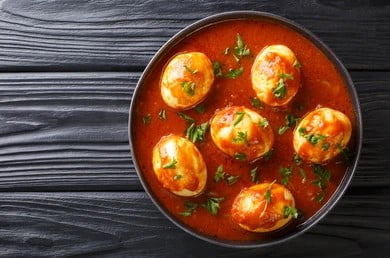
Ingredient List
For the Base Gravy:
For the Eggs and Final Preparation
Instruction lists:
Cooking Steps:
-
Prepare the Base
- Heat oil or ghee in a pan. Add cumin seeds, cardamom pods, cinnamon, and cloves. Give them time to sizzle for a few seconds.
- add the finely chopped onions and Saute it until they turn golden brown.
- Cook for a further minute after adding the ginger-garlic paste, or until the raw smell is gone.
-
Create the Gravy
- When the oil separates from the mixture, add the tomato puree to the pan and continue cooking.
- Add 2 tablespoon butter in it.
- Stir in the salt, turmeric, coriander, and Kashmiri red chili powders.
- Now when all the ingredients are well mixed turn off the gas.
- When the mixture cools down a little, blend it with the rest of the mixer.
- Now strain it with the help of a strainer.
- Pour this smooth mixture back into the pan.
-
Integrate Creaminess
- In a blender, combine soaked cashew nuts with a little water and blend into a smooth paste.
- After lowering the heat, Pour the cashew paste. Stir and cook for 2-3 minutes, allowing the flavors to meld.
- Gradually add yogurt, stirring continuously to prevent curdling. Cook until the gravy thickens slightly.
-
Incorporate Eggs
- Gently add the boiled eggs to the gravy.
- Let them simmer in the sauce for about 5-7 minutes, ensuring they absorb the flavors.
- Sprinkle garam masala over the curry.
- Taste and adjust salt and spice amounts accordingly.
- Garnish with freshly chopped coriander leaves.
- Shahi Egg Curry is best served hot with naan, rice, or roti.


